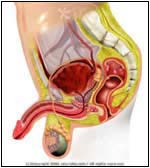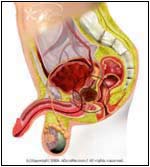|
|
 |

Normal |

Abnormal |
|
|
- The Prostate is a gland in males that surrounds the neck of the bladder (where urine is stored) and the urethra (urine leaves the bladder and exits the penis via this canal). During sex, the prostate secretes a milky fluid (necessary to keep sperm alive) that mixes with sperm and makes semen. The prostate is also the source for testosterone (an important male sex hormone) metabolism.
- Cancer of the Prostate refers to the growth of abnormal cells (tumor) within the prostate that destroy its structure and spread to other sites in the body.
- PC is the third leading cause of cancer death in men.
|
 |
- Slow growing tumor -- may take years for symptoms to develop
- Frequent urination
- Weak urinary stream
- Interruption of urinary stream (starting-stopping)
- Pain on urination
- Burning on urination
- Urinary dribbling -- urine drips after urination
- Difficulty in starting urination
- Pinkish urine or blood in urine
- Inability to urinate
- Pain during ejaculation
- Pain on moving the bowels
- Weight loss
- Loss of appetite
- Weakness and fatigue
- Shortness of breath
- Bone pain -- lower back pain, thighs, etc.
- Fractures may occur
- Urine infections may occur
- Blood clots may form in the legs
|
 |
- Unknown
- Prostate Cancers are classified (staged) by how aggressive they are and by the degree that they differ from the surrounding prostate tissue.
- The staging most generally used classifies the cancer into:
- A -- the doctor is not able to feel the tumor on exam, but a biopsy (piece taken) will show the cancer cells under a microscope.
- B -- the tumor is felt on the exam, but is still limited to the prostate.
- C -- the tumor has extended outside the prostate, and may have invaded some of the nearby tissues (e.g., seminal vesicles and lymph nodes), but has not spread to distant body parts.
- D -- the tumor cells have used the blood stream and
lymphatic system (a system carrying a fluid containing
white blood cells) to spread to distant body parts and
organs (e.g., bones, lungs, liver, kidney, etc).
|
 |
- Symptoms
- Illnesses
- Family history
- Dietary history
- Habits
- Surgeries
- Occupation
- Medications
- Allergies
- Most important is the direct examination of the prostate (rectal exam) by the doctor.
- By inserting his index fingers in the rectum (using a gel) the doctor may discover an enlarged, irregularly-shaped, hard mass.
- PSA is a chemical secreted by prostate cells to keep the semen liquid -- cancer cells produce a lot of PSA.
- PSA (prostate specific antigen) is elevated to values of > 4 -10 ng/ml. Values above 10ng/ml are strongly suggestive of Prostate Cancer.
- PSA can also be elevated with non- cancerous enlargement of prostate (BPH) and other factors.
- Free-PSA is new blood test -- low levels of free-PSA are seen in Prostate Cancer.
- Alkaline phosphatase enzyme may be elevated with bone metastasis (spread to the bone).
- Urine analysis may show red blood cells or, rarely, the cancer cells (cytology). Prostate Ultrasound (using sound) is performed by a microphone-like device that is inserted into the rectum to take pictures of the tumor.
- A Biopsy of the tumor is done by inserting a biopsy device into the rectum and removing a tiny piece of the tumor to be sent to a laboratory and examined under a microscope (view cancer cells).
- Chest X-Ray may show metastasis to lungs.
- Bone scan is a special radiologic test that can show metastasis to the bone.
- CAT scan (using computers) can show metastasis to other organs such as lungs and kidney, as well as to the lymph nodes.
- To find the stage to which the cancer has progressed (i.e., outside the prostate, Stage C or greater), a surgeon may need to do a lymphadenectomy by entering (using a camera called laproscope) the lower part of the abdomen and removing the pelvic lymph nodes (lymph glands near the prostate).
|
 |
- Age -- rarely occurs under 40, but very high rate in those over 75
- Eating animal products (fats) -- Japanese (high fish diet) and vegetarians have a lower incidence (chance of having) of PC
- Diet low in Zinc and vitamins such as E may play a role.
- Family history of PC and, in some cases, Ovarian Cancer (in mothers and sisters)
- African American males have highest rate of PC.
- Highest rate occurs in northern Europe and America.
- Lowest rates seen in Israel, Russia, and Japan.
- Moving from lowest risk areas to highest risk areas.
- Sexually transmitted diseases may play a role in PC.
- Hormones (i.e., testosterone) -- men who have been castrated (testicles removed) do not develop PC.
- Alcohol
- Smokers do worse when diagnosed with PC.
- Cadmium, Acryl Nitrite, and Dimethylformamide (DMF) exposure
- Farmers
- Vasectomy
- Non-melanoma skin cancer
|
 |
- The doctor may consult with an urologist (male urine, prostate, penis doctor), surgeon, and oncologist (cancer specialist).
- Treatment depends on the stage of cancer.
- If biopsy shows a pre-cancerous (not yet cancer) condition known as intraepithelial neoplasia, treatment is necessary, and close observation and follow up will be needed (every 3-6 months for 2 years).
- When diagnosed in early stages (A-C), the cure rate is almost 98%.
- Because of the slow rate of growth, early stages can often be watched and followed clinically.
- Aggressive therapies (surgery and radiation) are often recommended for younger men (50 and younger) who have a life expectancy of 10 years or longer.
- Surgery and radiation both have many side effects including Impotence (inability to have an erection) and incontinence (inability to control or hold urine).
- Stages of A (A1 and A2) or age > 70 are often followed without treatment.
- For other stages without metastasis
and low grades of stage C (C1) -- prostatectomy
(surgical removal) of prostate and/or radiation (using radioactive substances or X-Rays) therapy are the options.
- For stages of C (more advance C2) and D -- chemotherapy (cancer killing drugs), hormone therapy using medications (Eulexin, Leupron, Zoladex), or removing the testicles (orchiectomy) may be combined with radiation.
- Pain management -- medications and therapies such as massage and physical therapy can help with pain.
- Eat a diet high in vitamins, zinc, vitamin E, fish, fruit, and vegetables.
- Ketoconazole and other drugs, immunotherapy (drugs that enhance the body's natural defenses), and the use of herbs such as PC-SPES are all being researched as forms of therapy.
- American Cancer Association recommends all men to have a PSA and rectal exam every year starting age 50.
- African Americans and those with risk factors may start as early as age 40.
|
 |
-
Contact
your physician. Treating or not treating PC depends on your age, other medical problems, and lifestyle. PC is slow growing in most cases, so do not lose hope. Ask about new research and clinical trials. You can call the American Cancer Institute for more Information at 1-800-4 -CANCER.
|
 |
- Benign prostatic growth -- non-cancerous growth
- BPH-benign prostatic hyperplasia -- prostate begins to enlarge after the age of 40 in most men
- Prostatitis
-- inflammation (swelling) due to infection
- Prostatitis --
the accumulation of fluid in prostate
- Prostate stones
- Seminal vesicle (tiny tubes transporting sperm) enlargement
|
| | |
If you want your friend to read or know about this article, Click here
 |
|
|

